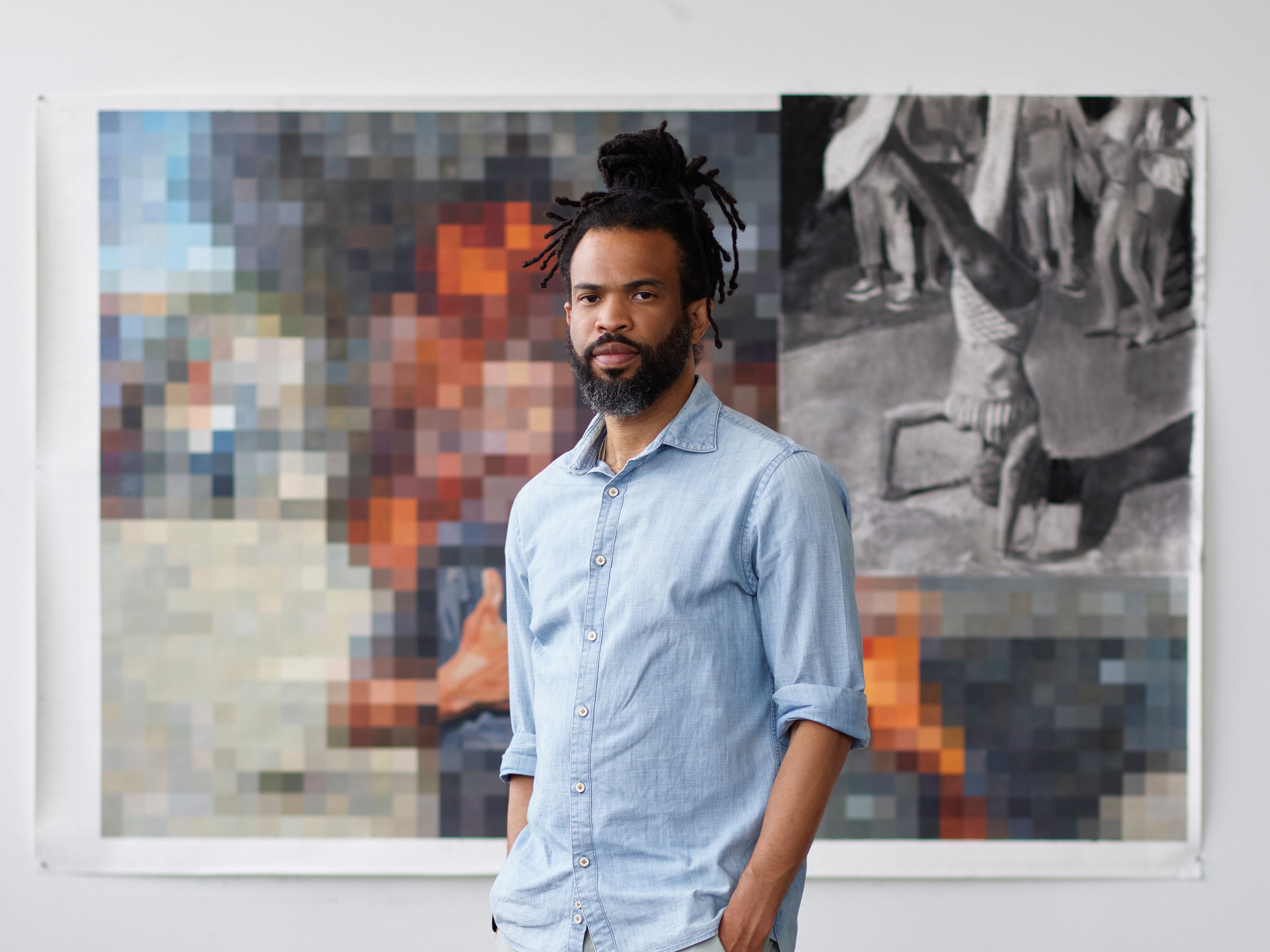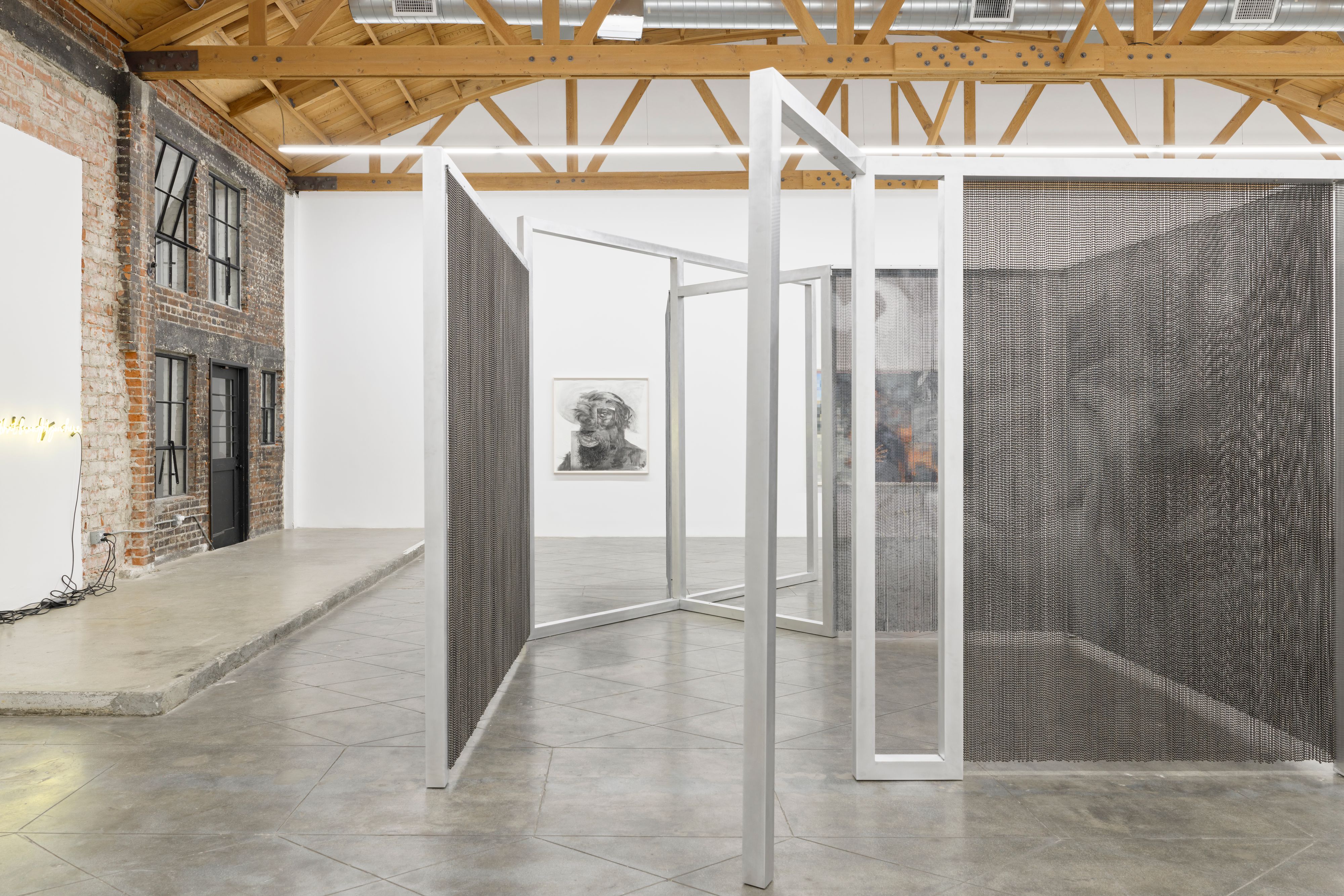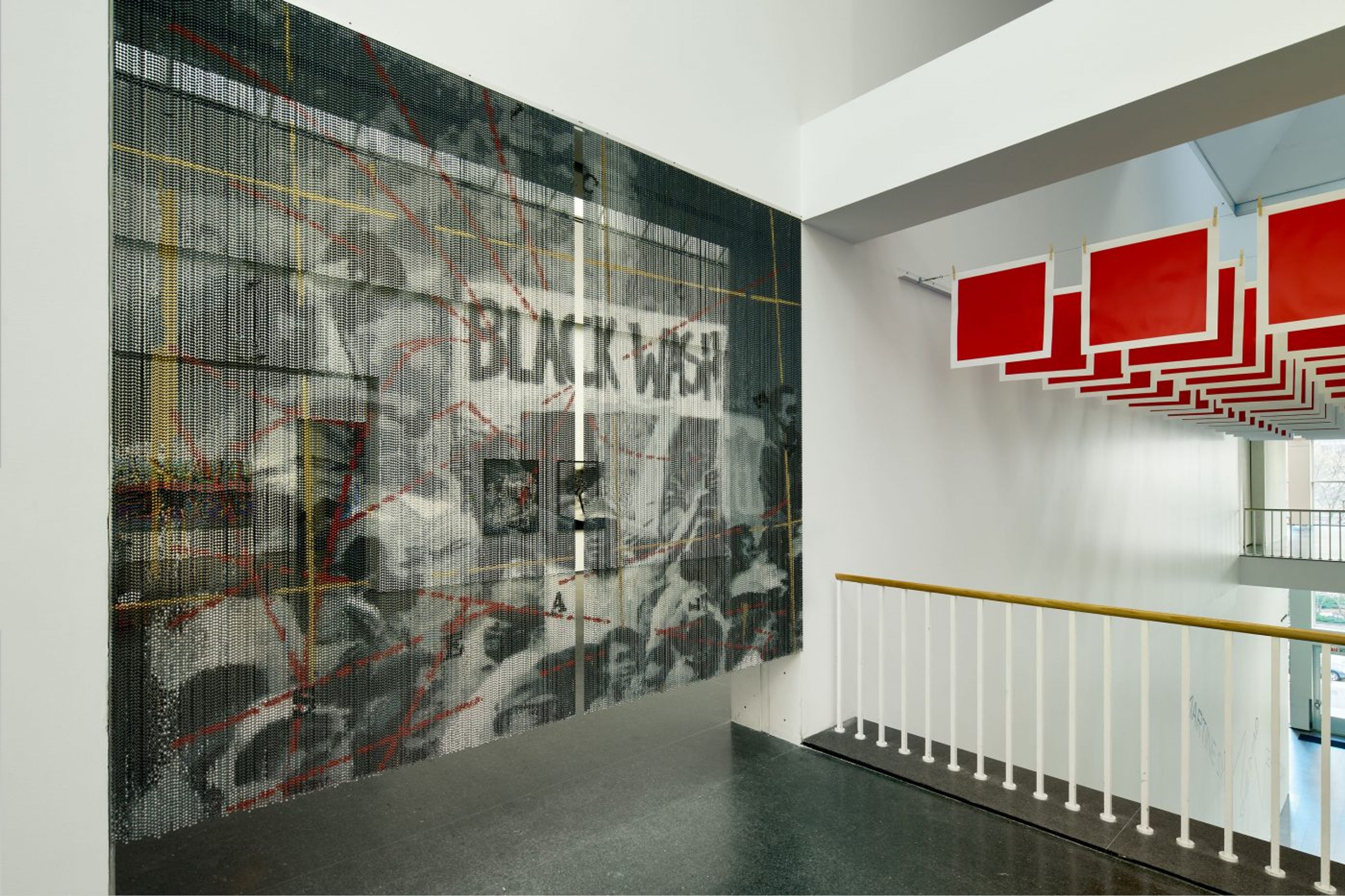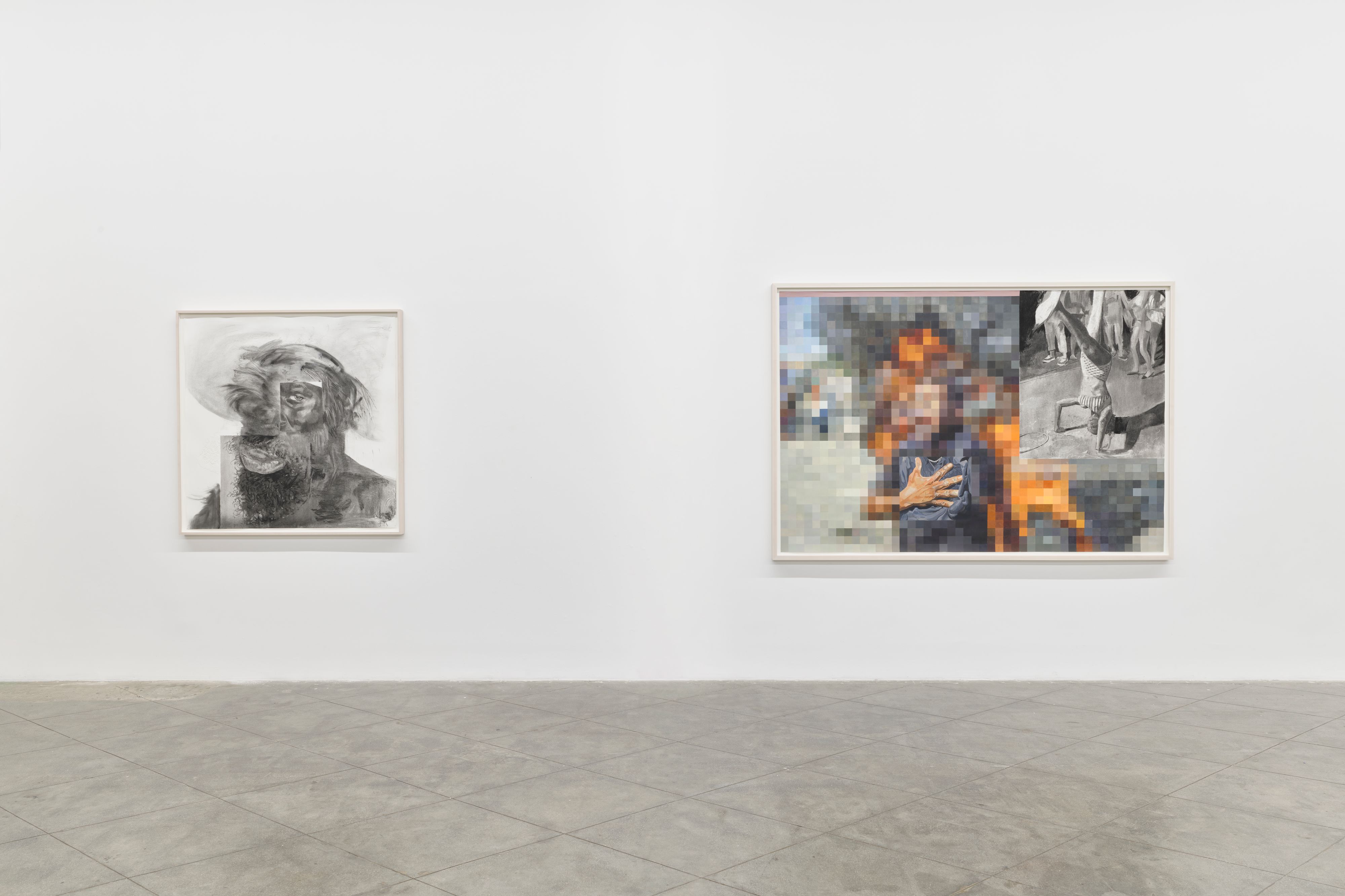BEADED CURTAINS, FAMILY LEGACIES, AND THE POLITICS OF IMAGE-MAKING
AN INTERVIEW WITH COSMO WHYTE
by Natalia Torija Nieto
Portrait of Cosmo Whyte. Courtesy of the artist and Anat Ebgi, Los Angeles. Photographer: Matthew Kroening.
Artist Cosmo Whyte was born in 1982 in St. Andrews, one of 14 parishes established by English colonizers in Jamaica in the 17th century. A prolific draftsman, Whyte reinterprets archival images of human injustice and agitation within the Caribbean and West African diaspora, questioning the contemplation of the images themselves, the sites in which the photographs were taken, and the context in which they are now being replicated and shown. His portraiture often obscures details that could reveal something ostensibly crucial about the subject. A transplant to the United States currently based in Los Angeles, Whyte’s understanding of place and identity often fluctuates as he has studied, practiced, and taught in cities like Atlanta, Ann Arbor, Chicago, and Tallahassee.
Recently, Whyte returned to his late architect father Cosmo Charles Whyte’s unfinished blueprints for reference, honoring his ideas about circulation between public and private spaces. Whyte’s solo show at L.A.’s Anat Ebgi from earlier this year Hush Now, Don’t Explain connected his and his father’s archives through the design of metal structures that hold Whyte’s signature hand-painted bead curtains, an element present throughout his work that is inspired by thresholds in what he terms “porous” Jamaican architecture. The curtains often depict a person or group in a state of unrest, challenging visitors on whether they have the right to traverse through (the image of) another person’s struggle.
Through the years, grieving the loss of a loved one is an ongoing process that “just becomes less immediate in intensity, [though] there are waves,” Whyte says. The hand-drawn impressions of both him and his father, dream-like muddied images, are forms of remembrance and reclamation.

Installation view of Cosmo Whyte's Hush Now, Don't Explain at L.A. gallery Anat Ebgi, with 4/4 Timing (Curtains), 2023, in the foreground. Courtesy of the artist and Anat Ebgi, Los Angeles. Photographer: Matthew Kroening.
Natalia Torija Nieto: What made you want to look at your father’s architectural drawings and transform them into your own language through your work?
Cosmo Whyte: Shortly after he passed away, and I mean, within weeks, I was going off to art school for a one-year Post Baccalaureate at Maryland Institute College of Art (MICA, 2007). It was a really interesting time to be there, right in the middle of that grief, and I immediately started processing [it] through schoolwork. The very first set of archival explorations happened during that period of time of materials’ study. I was using a lot of his heirloom materials to create work. The very first artwork that I’ve ever created happened while I was at MICA, and it was a piece very much grappling with his passing.
NTN: What was the piece?
CW: It was my first foray into installation, a stop motion animation featuring my drawings — the only stop motion animation I’ve ever done — and a sculpture with a projection of live footage video that I had captured. I’ve only ever shown it once since. But I consider that to be the very first artwork I ever did. It was a slow progression to get to this point where I’m reinterpreting [my father’s] drawings and making these structures. And I do feel like this is the first iteration; there’s so many ways I can see this being pushed further.

Cosmo Whyte’s curtain work Beyond the Boundary (2022) drapes over the entryway in the the group show Forecast Form: Art in the Caribbean Diaspora, 1990s–Today, on view until February 2024 at the ICA in Boston. Photo courtesy of the artist.
NTN: What types of architecture was your father working on?
CW: In Jamaica, there’s not that big of a distinction between commercial and domestic architecture. You are expected to do all of it. But I was particularly looking at the domestic spaces he designed. He liked to create this opening within the domestic space that had a potential to invite a more public kind of engagement. The drawings [I selected] are the thresholds to get into those public spaces.
NTN: What has your relationship to architecture been like?
CW: I’ve been thinking a lot about growing up in the Caribbean, specifically Jamaica, and seeing architecture as always being porous, all of these structures incomplete, but built in such a way that they still function as a space that you can occupy, live in, and slowly expand over the years. The parts that are incomplete often take on a porous quality — you can look from one end of the building into the landscape on the other side. I find this fascinating as I believe this both challenges what constitutes a habitable structure and this incompleteness puts pressure on Western conceptions of architecture, which prioritize enclosure, objectiveness, and regulated spatiality. It’s also a reflection on this kind of limbo state that a nation that has gone through a colonial process is in. So this sense of porous architecture is a throughline in the way I’m thinking about the discipline now. My beaded curtain interventions, which you can walk through, are often inserted into the architecture of a space. There’s a sense of uncertainty initially. And the images are always politically charged. The [drawings] that I’m reinterpreting now are really just the infrastructure that allows you to see through all the different layers.
NTN: In TK Smith’s interview with you from 2020, Smith says that under colonialism, “to survive, some resign themselves to willful ignorance, while others sever their limbs.” This reminds me of your friend, Jamaican artist Ebony G. Patterson’s work. You both come from the same land and are questioning these ideas of what it means to settle in a place. How does this come across in your process?
CW: Every time I move somewhere, it complicates my understanding of place, and it also complicates my understanding of Jamaica even further. But I think one of the formative aspects of growing up in Jamaica, for me, was being cognizant of the fact that history is always on the surface level — you can’t really hide from it. In America, there are ways in which there’s this invitation to forget, but you’re not afforded that in places like the Caribbean. So this sense of always feeling like you’re butting up against history, that friction of where the country wants to go,where it is right now, and its past — that is something that I’ve taken with me everywhere I go.
NTN: This thing about “being allowed to forget” and turning a blind eye, is that related to the title of your solo show Hush Now, Don’t Explain?
CW: Yes, that’s part of it. Knowing that you have an unworthy lover. I like the title because it’s open to many different interpretations. There’s this [video] where James Baldwin is in conversation with Nikki Giovanni and she offers the same kind of tension: “You lie all the time, I need you to lie to me as well… Sometimes I need that.” But then also within the title I’m thinking about Édouard Glissant and this refusal of full transparency, leaving certain things opaque and a declaration that there’s no need to explain everything. I liked it because it could work on so many different layers.
NTN: Your work also touches on histories of migration. What has been your experience with this topic?
CW: It varies at different points. There was a period where the work was really focused on this very silent and personal experience that I feel is unique to that immigrant experience where the person you were prior is shattered open and you’re kind of reassembling yourself. I also think one cannot talk about migration without talking about the places that will be most impacted by climate change. I mean, with places like the Caribbean that are on the front line, what is that migration going to look like? You also can’t divorce that from colonial histories. I’ve always tried to complicate it for myself, to make it more nuanced. Whether you’re dealing with these archival images of social moments of unrest or a topic like migration, the artist has an ethical responsibility. I’m always trying to make these little amendments to the body of work.

Installation view of Cosmo Whyte's Hush Now, Don't Explain at L.A. gallery Anat Ebgi. Left: An eyewitness account, 2023; right: Agitation 5- The Agitators, 2023. Courtesy of the artist and Anat Ebgi, Los Angeles. Photographer: Matthew Kroening.
NTN: I read that you were re-reading Susan Sontag’s book Regarding the Pain of Others (Farrar, Straus and Giroux, 2003) grappling with the numbness of being surrounded by images of violence. How do you select your images?
CW: First of all, I tend to be very sensitive about not reproducing violence. This numbness that you’re talking about is part of what drives this kind of project. I remember, particularly in the latter years of the Obama administration, and into the Trump administration, we were just bombarded with all of these images. I remember asking myself, “What is the difference between a witness and an observer? What are the different types of relationship we have to these images? What is the image calling us to do? What is our responsibility to the image?” In terms of picking the image, there’s always more of an emphasis on that moment of agency, as opposed to a violence being placed onto the body.
I’m also thinking about the intrusive history of the camera, particularly in documenting Black and brown bodies, and ways of disrupting that — even momentarily, or symbolically. I’m particularly drawn to photographs in which the photographer has chosen, for their own protection, to leave their name out and remain anonymous. It’s often a photograph of one of these social agitations because in those moments, the photographer has to be as anonymous as the protesters on the street. These are some of the factors that guide me.
NTN: What does it mean for you to use materials from your personal collection versus images from journalistic archives? How do you make the distinction between the public and the private as you translate the material into your own language?
CW: My creative process has always begun with the interrogation of my own archives. In some cases that is my body — racialized as Black, gendered as man — personal memories, and in other cases physical materials such as heirlooms and now my father’s drawings. My approach has always been to use these personal archives as an entry point into collective political interrogations [or] public archives. As the work is translated into my own artistic language or poetics I am interested in blurring the lines between public and private archives.
NTN: What are your conversations like with other artists that share this sensibility, yet have different ways of approaching a subject?
CW: I love it. It’s one of those things where you have a greater appreciation for the way in which someone else is taking in that information and representing it in ways that are nuanced and complex. It enriches the conversation further. I look at [Ebony G. Patterson’s] work, and I’m keenly aware that there are things that she’s making that I would never think to make, and I love that and I hope she feels the same about mine. When you take all of those works of various artists and put them together, you get a larger picture — the true story.